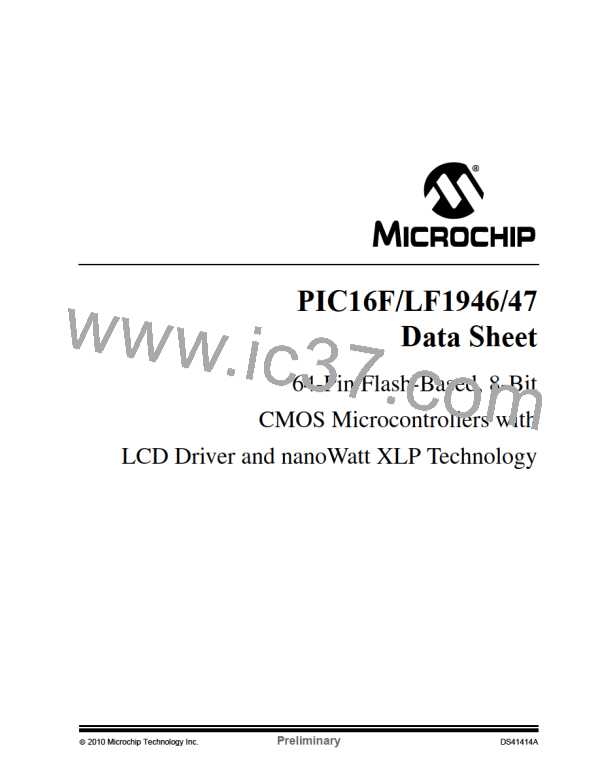PIC16F/LF1946/47
TABLE 29-5: RESET, WATCHDOG TIMER, OSCILLATOR START-UP TIMER, POWER-UP TIMER
AND BROWN-OUT RESET PARAMETERS
Standard Operating Conditions (unless otherwise stated)
Operating Temperature -40°C TA +125°C
Param
No.
Sym.
TMCL
Characteristic
Min. Typ† Max. Units
Conditions
30
MCLR Pulse Width (low)
2
5
—
—
—
—
s VDD = 3.3-5V, -40°C to +85°C
s VDD = 3.3-5V
31
TWDTLP Low-Power Watchdog Timer
Time-out Period (No Prescaler)
10
18
27
ms VDD = 3.3V-5V
32
TOST
Oscillator Start-up Timer Period(1), (2)
—
1024
65
—
140
2.0
Tosc (Note 3)
33*
34*
TPWRT Power-up Timer Period, PWRTE = 0 40
ms
TIOZ
I/O high-impedance from MCLR Low
or Watchdog Timer Reset
—
—
s
35
VBOR
Brown-out Reset Voltage
2.38
1.80
2.5
1.9
2.73
2.11
V
BORV=2.5V
BORV=1.9V
36*
37*
VHYST
Brown-out Reset Hysteresis
0
1
25
3
50
5
mV -40°C to +85°C
TBORDC Brown-out Reset DC Response
Time
s VDD VBOR
*
These parameters are characterized but not tested.
†
Data in “Typ” column is at 3.0V, 25°C unless otherwise stated. These parameters are for design guidance
only and are not tested.
Note 1: Instruction cycle period (TCY) equals four times the input oscillator time base period. All specified values are
based on characterization data for that particular oscillator type under standard operating conditions with the
device executing code. Exceeding these specified limits may result in an unstable oscillator operation and/or
higher than expected current consumption. All devices are tested to operate at “min” values with an external
clock applied to the OSC1 pin. When an external clock input is used, the “max” cycle time limit is “DC” (no
clock) for all devices.
2: By design.
3: Period of the slower clock.
4: To ensure these voltage tolerances, VDD and VSS must be capacitively decoupled as close to the device as
possible. 0.1 F and 0.01 F values in parallel are recommended.
FIGURE 29-10:
TIMER0 AND TIMER1 EXTERNAL CLOCK TIMINGS
T0CKI
40
41
42
T1CKI
45
46
49
47
TMR0 or
TMR1
2010 Microchip Technology Inc.
Preliminary
DS41414A-page 401

 MICROCHIP [ MICROCHIP ]
MICROCHIP [ MICROCHIP ]